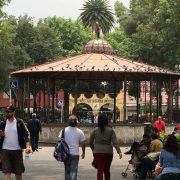An Ode to Nairobi Transit: Part I
By David Leipziger MURP/MBA 2017
Since I am working on urban transit in Nairobi, it is worth penning my observations on transportation in the city.
The prevailing form of transit in Nairobi is the matatu system. Matatus (so-called, the legend goes, because of the Kikuyu word for the typical fare of “thirty cents”—mang’otore matatu) are fleets of privately operated buses that operate without schedules on mostly designated routes. According to the city’s master plan, there are more than 90,000 matatu vehicles serving the Nairobi metro area. Matatus account for more than half of daily passenger trips. By comparison, the much larger Los Angeles County has about 2,200 buses and transit serves 11% of all trips.
The first amazing aspect of the matatu network is its efficiency. During the morning peak, major commuter routes can experience headways of just 30 seconds. The city-wide average for morning peak headways is 3 minutes. Just to clarify, that’s bonkers. New York City’s subway averages 2-8 minute headways during rush hour.
The matatu industry is organized into companies with fleets of anywhere from 1 to 100 buses. Matatu companies are either limited liability companies that lease buses and employ direct staff, management companies that franchise operations under a common brand, or cooperative credit institutions that pool resources as collateral. This latter type, called Savings and Credit Companies (SACCOs), typically have about 20 members and elect a management board to oversee route operations.
The second great thing about matatus is their musical stylings. Flair and persona are essential characteristics to mutatu owners, vehicles, and companies. Branding often plays out through soundtracks. And it’s great. Tracks I’ve heard this week include:
“Everything is Everything” – Lauryn Hill
Every song ever released by Rihanna
“Will You Be There” – Michael Jackson
“Believe” – Cher
“Give You My Heart” – Toni Braxton
“Bailando” – Enrique Iglesias
“Love Will Save the Day” – Whitney Houston
Although you’d never guess it based on these jams, the matatu network has its flaws. Issues like safety, reliability, and customer service are primary concerns. Many matatu conductors drive recklessly: earlier this month a matatu accident killed 2 people, and the government shut down the offending SACCO as punishment for lax standards. Such careless behavior is usually the product of operators trying to maximize their daily sales. Scrambling to make a buck can also lead drivers to over-fill vehicles and discriminate against certain passengers. On top of all this, corruption by police and organized crime is rampant.
But, the matatu industry is not as lawless as it may seem. Yes, there is always a morass of vehicles tangled up downtown, but we should not confuse things like high demand and route complexity with disorder. Even the description—which I’ve so often heard in the U.S.—of informal transit is imprecise. Most matatus are formally registered with the Matatu Owners Association or Matatu Welfare Association. A large portion passes inspections bi-annually and follows a litany of rules from the federal, regional, and city levels. Government regulations require standard staff wages, a registered business or cooperative entity accountable for each vehicle, seatbelts for riders, and speed limiting devices on all vehicles. Technically, all matatu staff must wear uniforms. Compliance rates vary, but so does enforcement.
In short, this is not an unregulated industry, much less an informal one. The government defines what routes matatus can operate on and creates the public infrastructure for bus stages (a.k.a. stops) citywide. As the city continues to invest in mass transit and regulations continue to pile on, the matatu industry will likely get even safer and more organized. We often forget that the first American transit was provided by a bunch of ragtag private sector entrepreneurs who bristled against regulation.










